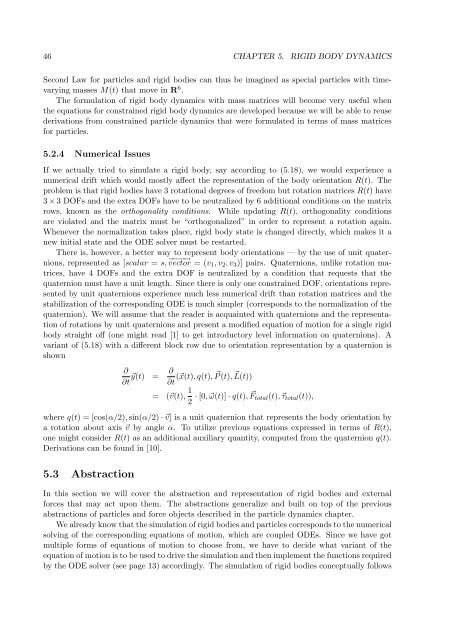thesis - Computer Graphics Group - Charles University - Univerzita ...
thesis - Computer Graphics Group - Charles University - Univerzita ...
thesis - Computer Graphics Group - Charles University - Univerzita ...
Create successful ePaper yourself
Turn your PDF publications into a flip-book with our unique Google optimized e-Paper software.
46 CHAPTER 5. RIGID BODY DYNAMICS<br />
Second Law for particles and rigid bodies can thus be imagined as special particles with timevarying<br />
masses M(t) that move in R 6 .<br />
The formulation of rigid body dynamics with mass matrices will become very useful when<br />
the equations for constrained rigid body dynamics are developed because we will be able to reuse<br />
derivations from constrained particle dynamics that were formulated in terms of mass matrices<br />
for particles.<br />
5.2.4 Numerical Issues<br />
If we actually tried to simulate a rigid body, say according to (5.18), we would experience a<br />
numerical drift which would mostly affect the representation of the body orientation R(t). The<br />
problem is that rigid bodies have 3 rotational degrees of freedom but rotation matrices R(t) have<br />
3 × 3 DOFs and the extra DOFs have to be neutralized by 6 additional conditions on the matrix<br />
rows, known as the orthogonality conditions. While updating R(t), orthogonality conditions<br />
are violated and the matrix must be “orthogonalized” in order to represent a rotation again.<br />
Whenever the normalization takes place, rigid body state is changed directly, which makes it a<br />
new initial state and the ODE solver must be restarted.<br />
There is, however, a better way to represent body orientations — by the use of unit quaternions,<br />
represented as [scalar = s, −−−−→<br />
vector = (v1, v2, v3)] pairs. Quaternions, unlike rotation matrices,<br />
have 4 DOFs and the extra DOF is neutralized by a condition that requests that the<br />
quaternion must have a unit length. Since there is only one constrained DOF, orientations represented<br />
by unit quaternions experience much less numerical drift than rotation matrices and the<br />
stabilization of the corresponding ODE is much simpler (corresponds to the normalization of the<br />
quaternion). We will assume that the reader is acquainted with quaternions and the representation<br />
of rotations by unit quaternions and present a modified equation of motion for a single rigid<br />
body straight off (one might read [1] to get introductory level information on quaternions). A<br />
variant of (5.18) with a different block row due to orientation representation by a quaternion is<br />
shown<br />
∂<br />
y(t)<br />
∂t<br />
=<br />
∂<br />
∂t (x(t), q(t), P (t), L(t))<br />
= (v(t), 1<br />
2 · [0, ω(t)] · q(t), Ftotal(t), τtotal(t)),<br />
where q(t) = [cos(α/2), sin(α/2) · v] is a unit quaternion that represents the body orientation by<br />
a rotation about axis v by angle α. To utilize previous equations expressed in terms of R(t),<br />
one might consider R(t) as an additional auxiliary quantity, computed from the quaternion q(t).<br />
Derivations can be found in [10].<br />
5.3 Abstraction<br />
In this section we will cover the abstraction and representation of rigid bodies and external<br />
forces that may act upon them. The abstractions generalize and built on top of the previous<br />
abstractions of particles and force objects described in the particle dynamics chapter.<br />
We already know that the simulation of rigid bodies and particles corresponds to the numerical<br />
solving of the corresponding equations of motion, which are coupled ODEs. Since we have got<br />
multiple forms of equations of motion to choose from, we have to decide what variant of the<br />
equation of motion is to be used to drive the simulation and then implement the functions required<br />
by the ODE solver (see page 13) accordingly. The simulation of rigid bodies conceptually follows
















